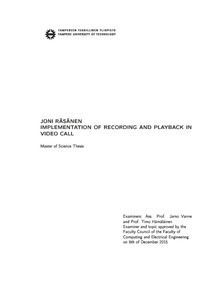Implementation of recording and playback in video call
Räsänen, Joni (2016)
Räsänen, Joni
2016
Tietotekniikan koulutusohjelma
Tieto- ja sähkötekniikan tiedekunta - Faculty of Computing and Electrical Engineering
This publication is copyrighted. You may download, display and print it for Your own personal use. Commercial use is prohibited.
Hyväksymispäivämäärä
2016-08-17
Julkaisun pysyvä osoite on
https://urn.fi/URN:NBN:fi:tty-201608034385
https://urn.fi/URN:NBN:fi:tty-201608034385
Tiivistelmä
Recording a video call recording is beneficial in cases like job interviews and business meetings. Skype or Google Hangouts for example have no recording implemented without additional plugins. MP4 file container is capable of containing different types of media tracks, is widely used and is supported by media players and has a feature called RTP/RTCP Reception Hint Tracks. Hint tracks contain media transmission instructions, which can be used, e.g., to record RTP stream into a file. Without this information the video call session cannot be replayed afterwards. The purpose of this Thesis is to implement and verify the usage of RTP and RTCP Reception Hint Tracks in video call recording.
No open-source MP4 multiplexing library or a media player with support for RTP/RTCP Reception Hint Tracks was found, so the support had to be implemented in both the library and the media player. The setup includes Linphone and L-SMASH for recording and VLC media player for playback. The created MP4 file has two RTP Reception Hint Tracks, two RTCP Reception Hint Tracks, and two media tracks. The GSM audio is chosen because it is supported by Linphone, L-SMASH, and VLC media player. H.264/AVC is chosen for video, because it is the best available codec supported by the three software.
Tests were carried out using two laptops with both having recording enabled. From the tests it is concluded that using the RTP Reception Hint Track increases the total CPU usage by less than 1% and the size of the recorded video call by 4% over the conventional media tracks. The implementation shows that RTP Reception Hint Tracks meet well the needs of implementations with choice of different codecs.
No open-source MP4 multiplexing library or a media player with support for RTP/RTCP Reception Hint Tracks was found, so the support had to be implemented in both the library and the media player. The setup includes Linphone and L-SMASH for recording and VLC media player for playback. The created MP4 file has two RTP Reception Hint Tracks, two RTCP Reception Hint Tracks, and two media tracks. The GSM audio is chosen because it is supported by Linphone, L-SMASH, and VLC media player. H.264/AVC is chosen for video, because it is the best available codec supported by the three software.
Tests were carried out using two laptops with both having recording enabled. From the tests it is concluded that using the RTP Reception Hint Track increases the total CPU usage by less than 1% and the size of the recorded video call by 4% over the conventional media tracks. The implementation shows that RTP Reception Hint Tracks meet well the needs of implementations with choice of different codecs.
